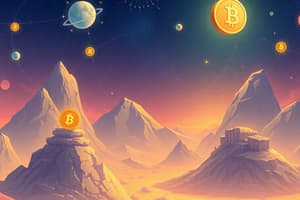Podcast
Questions and Answers
Considering the transformative potential of blockchain technology, how does the 'Internet of Value' fundamentally differ from the 'Internet of Information'?
Considering the transformative potential of blockchain technology, how does the 'Internet of Value' fundamentally differ from the 'Internet of Information'?
- The 'Internet of Value' enables secure transactions and ownership of digital assets, whereas the 'Internet of Information' primarily facilitates information sharing. (correct)
- The 'Internet of Value' is governed by international regulatory bodies, in contrast to the 'Internet of Information', which operates without oversight.
- The 'Internet of Value' relies on complex cryptographic algorithms, unlike the 'Internet of Information', which uses simple encryption methods.
- The 'Internet of Value' focuses on decentralized communication, while the 'Internet of Information' prioritizes centralized data storage.
Given blockchain's potential impact on the global economy, what is the most critical implication of its ability to secure digital rights, identities, and records?
Given blockchain's potential impact on the global economy, what is the most critical implication of its ability to secure digital rights, identities, and records?
- It establishes a foundation for new economic models based on decentralized trust and verifiable ownership. (correct)
- It centralizes control over digital assets, reducing the risk of fraud and unauthorized access.
- It enhances the efficiency of international trade by automating customs and border control processes.
- It simplifies compliance with existing regulatory frameworks by providing a transparent audit trail of transactions.
How does blockchain technology represent a paradigm shift comparable to the steam engine in terms of its impact on economic activity?
How does blockchain technology represent a paradigm shift comparable to the steam engine in terms of its impact on economic activity?
- By facilitating the globalization of financial markets, allowing capital to flow more freely across borders and increasing investment opportunities.
- By enabling new forms of decentralized organization, fostering greater transparency, and disintermediating traditional institutions. (correct)
- By accelerating the pace of technological innovation, leading to faster product development cycles and shorter time-to-market.
- By increasing automation in manufacturing, reducing the need for human labor and lowering production costs.
Considering blockchain's capacity to transform transaction security, which scenario exemplifies its most innovative application beyond traditional financial systems?
Considering blockchain's capacity to transform transaction security, which scenario exemplifies its most innovative application beyond traditional financial systems?
In what fundamental way does blockchain technology challenge conventional models of trust and authority in economic transactions?
In what fundamental way does blockchain technology challenge conventional models of trust and authority in economic transactions?
In the context of Web3, which combination of characteristics is essential for a product, protocol, or technology to be considered a part of it?
In the context of Web3, which combination of characteristics is essential for a product, protocol, or technology to be considered a part of it?
What fundamental aspect of blockchain technology has consistently proven reliable, even during periods of industry challenges?
What fundamental aspect of blockchain technology has consistently proven reliable, even during periods of industry challenges?
According to the content, how does Web3 redefine the relationship between individuals, their data, and digital assets?
According to the content, how does Web3 redefine the relationship between individuals, their data, and digital assets?
What primary areas of focus are expected to drive the growth and development of blockchain in 2024 and 2025?
What primary areas of focus are expected to drive the growth and development of blockchain in 2024 and 2025?
In the context of Web3, what does it mean for something to be 'permissionless'?
In the context of Web3, what does it mean for something to be 'permissionless'?
How does decentralization in Web3 change the dynamics of data control and ownership?
How does decentralization in Web3 change the dynamics of data control and ownership?
What characterizes the 'trustless' aspect of Web3 interactions?
What characterizes the 'trustless' aspect of Web3 interactions?
Considering the shift from Web2 to Web3, what is the anticipated impact on the prevailing business models?
Considering the shift from Web2 to Web3, what is the anticipated impact on the prevailing business models?
Which characteristic is MOST crucial for blockchains like Bitcoin and Ethereum to maintain their established credibility?
Which characteristic is MOST crucial for blockchains like Bitcoin and Ethereum to maintain their established credibility?
How do smart contracts MOST significantly enhance the credibility of transactions performed on a blockchain?
How do smart contracts MOST significantly enhance the credibility of transactions performed on a blockchain?
In the context of blockchain technology, what does 'immutability' primarily ensure regarding stored data??
In the context of blockchain technology, what does 'immutability' primarily ensure regarding stored data??
When a node proposes a new block, what is the PRIMARY reason the other nodes download and validate the complete block including its transaction history?
When a node proposes a new block, what is the PRIMARY reason the other nodes download and validate the complete block including its transaction history?
What is the MOST critical role of consensus mechanisms in blockchain technology?
What is the MOST critical role of consensus mechanisms in blockchain technology?
Within the context of the Blockchain Trilemma, what is the MOST accurate description of 'Scalability'?
Within the context of the Blockchain Trilemma, what is the MOST accurate description of 'Scalability'?
Considering the Blockchain Trilemma, what inherent trade-off often occurs when a blockchain prioritizes decentralization and security?
Considering the Blockchain Trilemma, what inherent trade-off often occurs when a blockchain prioritizes decentralization and security?
What is the PRIMARY function of tokenization in asset management using blockchain technology?
What is the PRIMARY function of tokenization in asset management using blockchain technology?
Which inherent trade-off is most accurately described by the blockchain trilemma?
Which inherent trade-off is most accurately described by the blockchain trilemma?
Why might widespread adoption of blockchain technology be hindered by the blockchain trilemma?
Why might widespread adoption of blockchain technology be hindered by the blockchain trilemma?
What distinguishes Bitcoin from traditional financial systems, as highlighted in the content?
What distinguishes Bitcoin from traditional financial systems, as highlighted in the content?
How do smart contracts enhance the functionality of blockchain technology?
How do smart contracts enhance the functionality of blockchain technology?
In what way does blockchain technology redefine transactions, differing from how the internet redefined information sharing?
In what way does blockchain technology redefine transactions, differing from how the internet redefined information sharing?
Beyond cryptocurrencies, what is a potential application of blockchain technology related to asset ownership?
Beyond cryptocurrencies, what is a potential application of blockchain technology related to asset ownership?
What is the significance of blockchain transcending physical and geographical barriers?
What is the significance of blockchain transcending physical and geographical barriers?
How might the characteristics of Bitcoin, such as being censorship-resistant and deflationary, impact its role as a store of value?
How might the characteristics of Bitcoin, such as being censorship-resistant and deflationary, impact its role as a store of value?
Which characteristic of blockchain technology most directly addresses the risk of single points of failure?
Which characteristic of blockchain technology most directly addresses the risk of single points of failure?
In the context of blockchain technology, what is the primary role of cryptography in securing the 'chain' aspect?
In the context of blockchain technology, what is the primary role of cryptography in securing the 'chain' aspect?
Considering the factors that affect the number of transactions a typical Bitcoin block can hold, how does increased network congestion primarily impact this number?
Considering the factors that affect the number of transactions a typical Bitcoin block can hold, how does increased network congestion primarily impact this number?
If a blockchain is described as 'trustless', what does this imply about the system's reliance on intermediaries?
If a blockchain is described as 'trustless', what does this imply about the system's reliance on intermediaries?
How does the characteristic of being 'pseudonymous' in a blockchain primarily affect user privacy?
How does the characteristic of being 'pseudonymous' in a blockchain primarily affect user privacy?
What is the fundamental role of a consensus mechanism in a blockchain network?
What is the fundamental role of a consensus mechanism in a blockchain network?
What describes the relationship between accounting ledgers, cryptography, business computer networks, and blockchain technology?
What describes the relationship between accounting ledgers, cryptography, business computer networks, and blockchain technology?
How does immutability, as a core characteristic of blockchain, contribute to the reliability and trustworthiness of recorded data?
How does immutability, as a core characteristic of blockchain, contribute to the reliability and trustworthiness of recorded data?
Flashcards
Blockchain Significance
Blockchain Significance
A technology transforming the global economy.
Internet of Information
Internet of Information
The first digital revolution that allowed the sharing of data.
Internet of Value
Internet of Value
The second digital revolution enabling secure transactions.
Blockchain's Redefinition
Blockchain's Redefinition
Signup and view all the flashcards
Anything of Value
Anything of Value
Signup and view all the flashcards
Decentralized (Web3)
Decentralized (Web3)
Signup and view all the flashcards
Permissionless (Web3)
Permissionless (Web3)
Signup and view all the flashcards
Trustless (Web3)
Trustless (Web3)
Signup and view all the flashcards
Internet of Value (Web3)
Internet of Value (Web3)
Signup and view all the flashcards
Blockchain
Blockchain
Signup and view all the flashcards
Distributed (Blockchain)
Distributed (Blockchain)
Signup and view all the flashcards
Decentralized (Blockchain)
Decentralized (Blockchain)
Signup and view all the flashcards
Peer-to-peer (Blockchain)
Peer-to-peer (Blockchain)
Signup and view all the flashcards
Blockchain Protocol
Blockchain Protocol
Signup and view all the flashcards
Cryptographic Hash
Cryptographic Hash
Signup and view all the flashcards
Block
Block
Signup and view all the flashcards
Typical # of transactions per block
Typical # of transactions per block
Signup and view all the flashcards
Distributed Ledger
Distributed Ledger
Signup and view all the flashcards
Decentralized
Decentralized
Signup and view all the flashcards
Immutable
Immutable
Signup and view all the flashcards
Blockchain Credibility
Blockchain Credibility
Signup and view all the flashcards
Data Authentication in Blockchain
Data Authentication in Blockchain
Signup and view all the flashcards
Asset Management in Blockchain
Asset Management in Blockchain
Signup and view all the flashcards
Smart Contracts
Smart Contracts
Signup and view all the flashcards
Initial Transaction Phase
Initial Transaction Phase
Signup and view all the flashcards
Block Creation
Block Creation
Signup and view all the flashcards
Blockchain Trilemma Elements
Blockchain Trilemma Elements
Signup and view all the flashcards
Blockchain Trilemma
Blockchain Trilemma
Signup and view all the flashcards
Open Blockchain
Open Blockchain
Signup and view all the flashcards
Closed Blockchain
Closed Blockchain
Signup and view all the flashcards
Digital Assets (Tokens)
Digital Assets (Tokens)
Signup and view all the flashcards
Blockchain Ledger
Blockchain Ledger
Signup and view all the flashcards
Eliminating Third-Party Interference
Eliminating Third-Party Interference
Signup and view all the flashcards
Bitcoin as Store of Value
Bitcoin as Store of Value
Signup and view all the flashcards
Study Notes
Blockchain Essentials 1: Topics
- Blockchain will change money, business, and the world
- This digital ledger of economic transactions will record everything of value and importance
- The global economy is undergoing the largest technological transformation in history
- Blockchain impacts the world's economic activity, and is described by some as the greatest innovation in computer science
- The first generation of the digital revolution brought us the Internet of Information
- The second generation revolution, powered by blockchain, will introduce us to the Internet of Value
- The internet has redefined how information is shared
- Blockchain is redefining how anything of value is transacted and secured
- Blockchain can secure currency, equity, assets, digital rights, identities, and records
Web3 Checklist
- Web3 is a product, protocol, or technology
- Web3 must meet 2 of 3 criteria to be considered web3 tech: Decentralized, Permissionless and Trustless
- Decentralized: Ownership is distributed among users; data is under the user's control.
- Permissionless: Anyone can access/participate in web3 without needing permission.
- Trustless: Users interact directly, without needing a third-party intermediary.
Blockchain Landscape (2023)
- Traditional business is about power and control.
- 2023 was challenging for the blockchain industry due to centralized power issues.
- Blockchain itself is not the point of failure as the underlying tech has never been the point of failure
- Decentralization is the future.
- The future of business demands decentralization for secure value creation and data protection.
Blockchain Landscape (2024+)
- 2024+ will bring the "Internet of Value."
- Web3, built on blockchain, creates a network of decentralized markets and communities.
- Web2 to Web3 represents the shift gives individuals/industries ownership of their assets, like money, data, and identities.
- The years 2024 and 2025 are focused on growth and development including, education, application, regulation and tech
- Blockchain is a protocol created using three existing technologies: Accounting Ledger, Cryptography, Business Computer, and Network Technologies
What is Blockchain?
- A global, digital, peer-to-peer, decentralized, and distributed database, also known as a ledger
- A public (potentially permissioned) electronic ledger built around a P2P system
- It is openly shared among disparate users
- It creates an unchangeable record of transactions that are time-stamped
- Each block holds a log of activity, such as transactions or information
- Each block links to the previous block using cryptography and is in chronological order to form a chain
Structure of Blockchain
- Blockchain is a linked list of encrypted blocks consisting of pointers and cryptographic hashes
- Every block after the first block contains the hash of the previous block's data
- Blocks store information validated by nodes that are cryptographically secured/encrypted
Cryptographic Hash
- Hashing takes an input (of numbers/letters) and processes it to create a smaller, fixed and encrypted output
- Hashing provides an efficient way to recognize and organize large pieces of data
- This is comparable to a URL shortener
Transactions in a Block
- The average number of transactions per block in the last 24 hours is 2,700 to 2,900
- Bitcoin confines its block size is limited to 1 MB
- Transaction counts are dependent on block size limit, transaction complexity, network congestion and Miner preferences
Blockchain Characteristics
- Distributed ledger
- Decentralized
- Block-based
- Cryptography
- Consensus driven
- Immutable
- Verifiable and auditable
- Pseudonymous
- Secures data in a distributed, peer-to-peer network
- A trustless system
Why Blockchain Technology
- Blockchain offers opportunities like: -No Third Party Involvement -Trusted Transactions -Reduced Costs -Transparency -Unalterable Records -Realtime tracking -Security -No single point of failure
- Additional benefits are a lack of middlemen, no central authority, and protection of privacy
- Extremely hack resistant
Security of Blockchain
- Distributed systems have no single point of failure.
- Blockchain is difficult to hack due to the power of the majority.
- A more distributed network is a more secure network.
- Larger & older blockchains (Bitcoin/Ethereum) have established security credibility.
Blockchain Specialties
- Data authentication and verification uses immutable storage, digital signatures, and encryption
- Asset management includes issuance, payment, exchange, escrow, and retirement.
- Crypto assets may be tokenized versions of real-world assets like gold, silver, or land
- Smart contracts allow credible transactions without third parties
Blockchain Essentials 2: Topics
- How it Works
- Types of Blockchains+
- Applications
- Summary
How does Blockchain work?
- A node on the blockchain (Bob) sends a transaction to another node(Alice)
- The transaction becomes part of a pool of pending, unconfirmed transactions.
- Nodes then pack these pending transactions into blocks.
- A chosen node proposes which block should be added to the chain
- All other nodes download the complete block, complete history of all transactions, check if the new transactions are valid
- If a consensus is reached, the block is accepted
- All nodes include the new block in the chain and update their copy/version of the blockchain
Illustrative example of Blockchain
- A transaction is requested by a blockchain node and sent to a block
- Validators validate the request in the block
- Once validated, it is sent to the blockchain and added
- The new version of the blockchain is sent to all nodes
Blockchain Trilemma
- Blockchain struggles to balance 3 elements: Security, scalability and decentralization
- Achieving all 3 is often difficult and is called the "trilemma"
- Projects will commonly focus on only 2 of the 3 elements of the trilemma
Types of Blockchain
- Public: Open, strong, but slower, needs more power
- Private: Closed, faster, less power, more control/centralized
- Consortium: Open and controlled by multiple organizations
- Hybrid: Blend of public and private, control and verification
Public vs. Private
- Public Blockchains are permissionless, anyone can read or write
- Everyone can add data or a record.
- Private Blockchains are permissioned and require specific authority to read and add data
- Only certain participants can write data
Open vs. Closed
- Open blockchains allow anyone to read data
- Closed blockchains only allow certain users to read the data
Examples of Blockchains
- Public & Closed: Voting, Public Records, Whistleblowers
- Public & Open: Currencies Bitcoin, Video Games and Ethereum
- Private & Closed: Construction, National Defence, Tax Returns, Healthcare Records, Enterprise Supply Chain
- Private & Open: Public Supply Chain, Government Financial Reporting, Corporate Earning Statements, Patents/IP Records
Token Types
- Tokens represent assets, currency, access rights, resources, equity, or collectibles
- Security/Equity Tokens: Digital token representing equity, debt, or other security
- Utility Tokens: Digital tokens created for consumption.
- Cryptocurrencies: Digital coins intended to be used as currency/exchanges
Applications of Blockchain
- Blockchain has applications in legal, supply chain, government, energy, food, and retail
- Also applicable in healthcare, insurance, travel and hospitality, and education
Use Cases of Blockchain
- Money / Cryptocurrencies - Store of Value, Unit of Account (price), Medium of Exchange
- Digital Assets (tokens)
- Can function as utility, equity, security, etc.
- May represent an asset, a record, an access right, etc.
- Smart Contracts
- A "computer protocol intended to digitally facilitate, verify, or enforce the negotiation or performance of a contract"
- A software or machine that is executing according to the contract (i.e., agreement or rules)
- Ledger
- Track ownership of assets (property title, equity, etc.)
- Offer timestamping of files
Blockchain Summary
- The Internet redefined information sharing, while blockchain redefines how we do transactions
- Blockchain transcends physical and geographical barriers, using math and cryptography for global transactions
- Blockchain retains peer-to-peer transactional history, cutting out fraud, hacking, and third-party interference
- Blockchain creates more opportunities and resources for individuals/industries globally
- Blockchain creates more efficiency, effectiveness, and accountability
- Blockchain saves time, money, and lives
- Blockchain innovation is moving very fast and there is still much to learn
- Blockchain is an environment in which new opportunities emerge every day across all industries, services, and trade
- Web3: Blockchain and AI will merge to become superpowers
- This represents true Technology Convergence
Studying That Suits You
Use AI to generate personalized quizzes and flashcards to suit your learning preferences.




